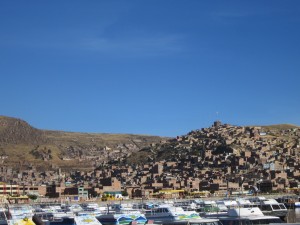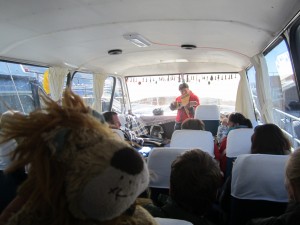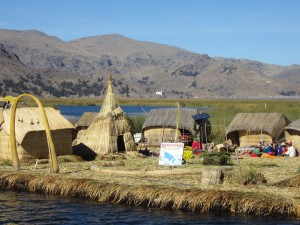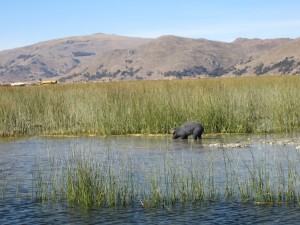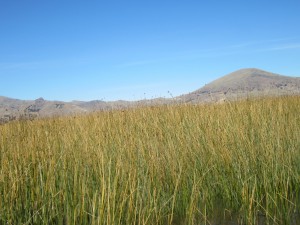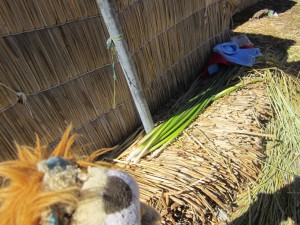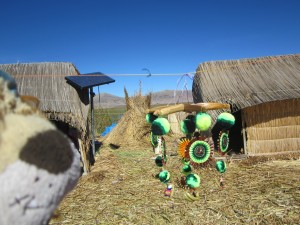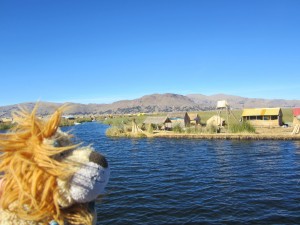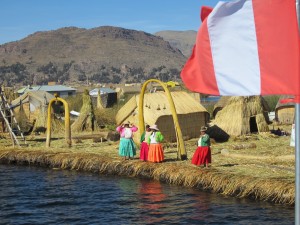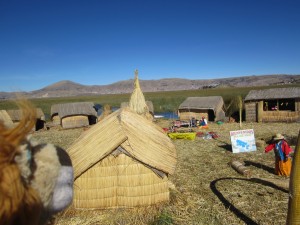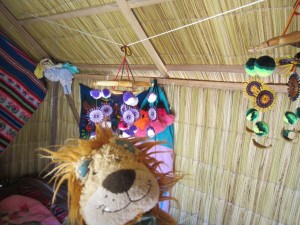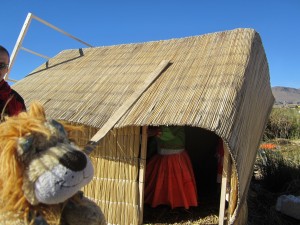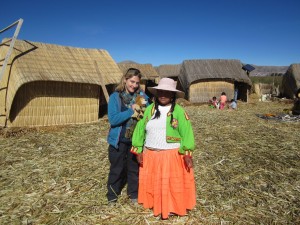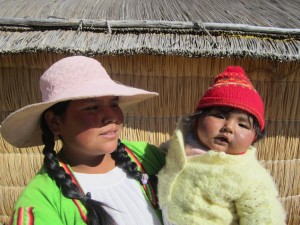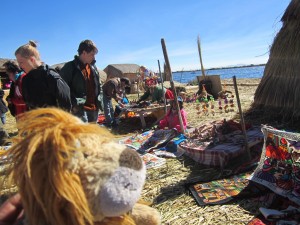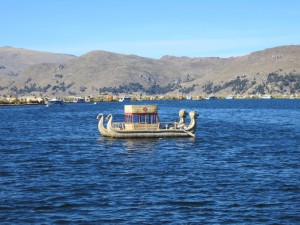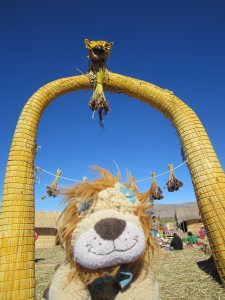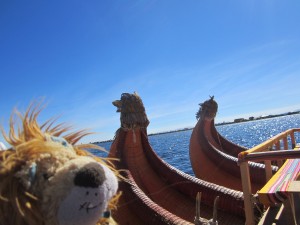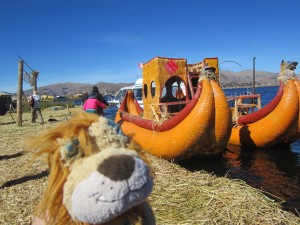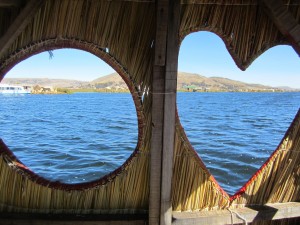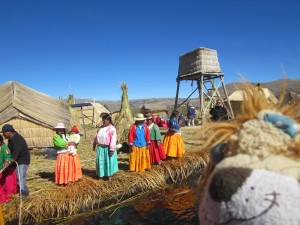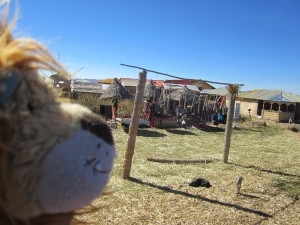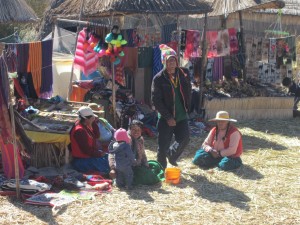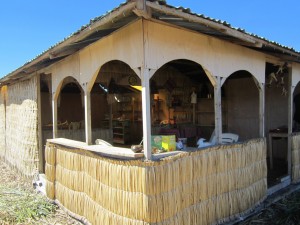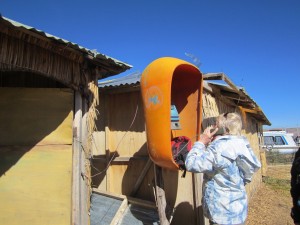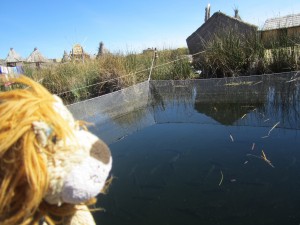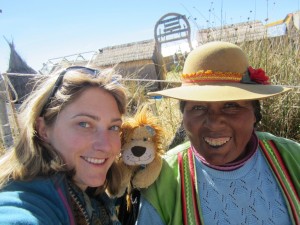Lewis the Lion and Helen were picked up early one morning by a lovely lady, Rosa, who taxied them down to Puno port. As they sat in the sunshine waiting for their boat to be ready, Lewis marvelled at all the pretty boats in the harbour set against the colourful city of Puno. Delightful!
As Lewis the Lion boarded the boat with some other people who were also going to do an overnight stay on the island of Amantani, they were entertained by some traditional Peruvian music. The clever musician was playing two musical instruments simultaneously: some panpipes and a little Andean guitar called a charango.
Click here to see a snippet on You Tube.
The group were then welcomed by the guide Jovanni who gave them some important information about travelling to the Uros or Floating Islands. First things first, if the travellers wanted to sit on the top of the boat in the sunshine, he reminded them that if they didn’t want ‘snake skin’ to wear adequate sun lotion as the reflections off the lake could be deceptive and they might burn.
He then talked about how ‘Mamacocha’ – the Mother Lake or ‘Tiki-ha-ha’ as they called it in Peru, (not ‘Titicaca’ as in Bolivia) was very sacred to the people in Peru and how people had lived on the lake for hundreds of years.
One such ancient indigenous people, are the people of the Uros Islands of which there are 40 islands on the lake. These are very particular islands as they are not natural and are not built on solid land or rock but rather on a bed of totura reeds which are layered on top of each other to keep the island afloat. They are only 2-3 metres deep and are layered around sticks. The blocks of reeds are layered up every month to stop the islands from sinking. When Lewis the Lion eventually stepped onto these islands he thought that they felt very spongy underfoot as if your feet might sink if you didn’t walk quickly enough!
Lewis the Lion then remembered how he had first seen reeds growing by the lake when he had first entered Peru and suddenly started to understand their importance for these people.
Not only are these plants used to create the land but they are used to build houses, reed boats, for fuel and are even used as a food source as they are rich in calcium and fibre. (The top part of the reed – the edible bit- has the same properties as a banana!).
In total, there are approximately 2,000 people living on the Uros Islands made up of 30-40 indigenous families. They even have an elected mayor who has recently brought solar panels to the islands so that they can generate their own energy!
Before the boat arrived at these unique islands, the guide taught the group some important words in Aymara for their visit to the islands. (Check out Lewis Loves Languages page for more information, including animal words in Aymara and Quechua).
These words were ‘Kamisaraki‘ meaning, ‘How are you?/ Good morning’, with the response ‘Wallaki‘ – ‘I’m fine, thanks.’
The guide told the group not to worry about remembering the new words as the islanders would make sure they got lots of repetition! Lewis the Lion being an avid language learner knew that the guide was right. When learning a new language, quite simply the more practice you get, the easier it is to remember the new words.
Do you find that too when you are learning languages in school? What helps you remember new vocabulary?
In half an hour or so, the boat caught sight of these strange, yellow straw-coloured islands and the villagers were waiting to greet the visitors.
Their brightly coloured clothes contrasted with the yellow of the islands.
The first island they landed on was la Isla de San Pedro and each islander took a group of tourists and made them feel very welcome, even inviting them into their homes so they could see these special houses made of reeds.
The islander who welcomed Lewis the Lion and Helen was a 19-year old girl called Melinda.
She liked Helen and Lewis the Lion so much that she even asked Helen to cut her baby daughter’s hair for the first time so that she could become her godmother!
Helen politely refused as she knew she wasn’t very clever with scissors (a bit like that hairdresser she had encountered in the jungle!) and didn’t want to make a mess of the poor baby’s hair!
The island only has 30 residents and the islanders make their living by selling their crafts and giving reed-boat rides to the tourists.
Lewis the Lion was incredibly impressed with how skilled these people were with their hands, obviously skills that had been passed on from generation to generation. He was so impressed that he even bought one of Melinda’s tapestry which she had taken a month to make!
Whilst he was on the island he kept thinking of the story of the ‘Three Little Pigs’ with the little pig who built his house out of straw. He thought that these people were very impressive to build their houses in this way. He thought it was even more incredible especially when the modern town of Puno is only half an hour away and yet these people chose to live in this way? He discovered that the Floating Islands even had three schools, two Catholic and one Evangelist for which teachers would travel from the mainland. These are all bi-lingual schools teaching Spanish and Aymara.
Before long it was time to leave the island of San Pedro and Lewis the Lion decided, for a small fee of 10 soles, to travel to the next island in one of the typical reed boats built by the men of the village.
He thought that it resembled a Viking ship with the animal figureheads at the stern of the boat. On his particular boat, there was a top and a bottom level with a round and heart-shaped windows.
As the boat pulled away from la Isla de San Pedro, the villagers came to wave them off and sang a goodbye song.
Click here to see the islanders of The Uros singing goodbye to their visitors.
Lewis the Lion laughed his hearty laugh when he met an entrepreneurial two-year old who made sure that all the passengers had paid their 10 soles!
‘She’d make a great business woman one day,’ Lewis chuckled to himself.
Within 10 minutes, the reed boat had arrived at another Floating Island called Tapipmoaka, where again the islanders had stalls laid out with their traditional crafts for sale.
This was another incredible island as the villagers had built a restaurant
and hotel rooms out of the totura reeds. It also had a working telephone booth
and a trout farm.
For all their traditional ways of living, Lewis was surprised to see these modern influences harmoniously integrated into their life-styles.
As the original boat picked up its passengers ready for a two-hour journey to the island of Amantani, Lewis the Lion thought about how the clever people of the Uros Islands lived in harmony with the environment around them.
How do you use the environment around you to your benefit?

